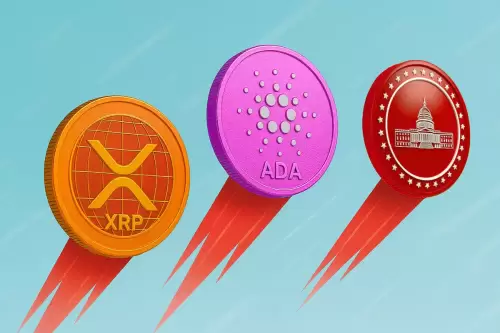 |
|
 |
|
 |
|
 |
|
 |
|
 |
|
 |
|
 |
|
 |
|
 |
|
 |
|
 |
|
 |
|
 |
|
 |
|
Cryptocurrency News Articles
Bitcoin Solaris Introduces Native Sharding to Remove Relay Bottlenecks and Achieve 87% Higher Throughput
May 17, 2025 at 03:00 am
Bitcoin Solaris has re-engineered this model from the ground up, leveraging a native sharding framework that removes reliance on centralized scheduling and enables 87% higher throughput

In the ongoing quest for blockchain scalability, Polkadot has emerged as a prominent contender, introducing a parachain system that coordinates multiple parallel chains through a central relay. This setup, while enhancing transaction capacity compared to legacy single-chain networks, still creates bottlenecks at the relay level, limiting throughput potential.
Bitcoin Solaris has taken a different approach, completely redesigning this model to realize the full potential of sharding in a dual-layer architecture, eliminating dependence on centralized scheduling and achieving 87% higher throughput than Polkadot in test conditions.
This isn’t a modified parachain model; it’s a clean-layer separation integrating a state-efficient sharding framework into the blockchain core. Combined with high-efficiency consensus mechanisms such as SEPoS and smart contract-native sharding logic, Bitcoin Solaris is able to achieve a performance profile designed for real-world usage at global scale, such as decentralized exchanges, gaming protocols, and on-chain AI orchestration — all domains where latency and block competition limit other networks.
Layered Sharding Over Relay Dependency
Bitcoin Solaris’s inherent scalability advantage arises from its architectural separation of execution and consensus. Each layer applies its own sharding logic, reducing cross-domain coordination and allowing for independent processing across the system:
* The lower Execution Layer is where smart contracts run, tokens are deployed, and transactions are executed. This layer is designed for maximum throughput and allocates shard boundaries based on optimal computational load.
* The upper Consensus Layer is dedicated to cross-shard coordination, block production, and finalization. This layer uses a smaller set of validator nodes that rotate regularly to ensure decentralized control.
This dual sharding model allows Bitcoin Solaris to bypass the slot-based validator scheduling used in Polkadot’s relay chain — where parachains must wait for their turn or bid for inclusion. Instead, Bitcoin Solaris’s throughput scales linearly with participant nodes, without centralized arbitration or network slowdowns.
Measured Performance: 87% Above Polkadot Benchmarks
Under controlled test conditions replicating real validator configurations, Bitcoin Solaris demonstrated sustained throughput exceeding 10,000 TPS, compared to Polkadot’s average of 5,300–5,700 TPS across active parachains. The improvement — an 87% gain — results from parallelized shard validation without bottlenecks at the chain coordination level.
This level of performance allows Bitcoin Solaris to handle high-frequency application domains such as:
* Decentralized exchanges with rapid cross-chain liquidity protocols
* Next-generation gaming protocols with on-chain integration and large user bases
* On-chain AI coordination and machine learning protocols
Polkadot’s parachain model, while innovative, is encumbered by a central relay that coordinates parachains, leading to throughput limitations, especially when demand surges during periods of high DeFi activity.
Crypto Chino analyzed Bitcoin Solaris’s sharding architecture In a side-by-side comparison, explaining how it surpasses Polkadot’s relay-based system in real-world performance and protocol simplicity.
Presale Phase 3: Access Ahead of Full Sharding Rollout
Bitcoin Solaris is now in Presale Phase 3, with BTC-S tokens priced at 3 USDT. This phase grants users early access to the network ahead of full sharding protocol activation and before listings on centralized exchanges.
The total supply is fixed at 21 million BTC-S, with 4.2 million (20%) allocated to presale across phases. There is no inflationary model. All future emissions are governed by validator participation and mobile mining distribution — ensuring early backers retain structural advantage as the network scales.
The sharding and execution models powering Bitcoin Solaris have been independently verified:
* Intertrust, a leading legal and technical consulting firm, conducted a comprehensive analysis of Bitcoin Solaris’s sharding architecture, concluding that it enables efficient parallel processing and shard-level finality.
* Chain Security, a blockchain auditing company, has completed a technical audit of Bitcoin Solaris’s smart contract code, confirming its security and alignment with best practices.
These third-party validations reinforce Bitcoin Solaris’s status as a scalable, high-assurance platform ready for next-generation deployment.
Polkadot advanced the scalability discussion — but Bitcoin Solaris delivers a cleaner, faster, and more flexible solution. With a true dual-layer sharding model, no auction bottlenecks, and 87% higher throughput, it sets a new benchmark for performance. As Phase 3 of the presale continues and validator activity ramps up, Bitcoin Solaris is redefining how next-generation chains scale — without compromise.
Website: https://bitcoinsolaris.com/ X: https://x.com/BitcoinSolaris Telegram: https://t.me/Bitcoinsolaris
Disclaimer:info@kdj.com
The information provided is not trading advice. kdj.com does not assume any responsibility for any investments made based on the information provided in this article. Cryptocurrencies are highly volatile and it is highly recommended that you invest with caution after thorough research!
If you believe that the content used on this website infringes your copyright, please contact us immediately (info@kdj.com) and we will delete it promptly.






























































